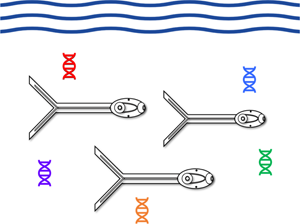Article contents
Lurking in the water: testing eDNA metabarcoding as a tool for ecosystem-wide parasite detection
Published online by Cambridge University Press: 28 October 2021
Abstract

In the light of global biodiversity change and emerging disease, there is an urgent need to establish efficient monitoring programmes of parasites in aquatic ecosystems. However, parasite identification is time-consuming, requires a high degree of taxonomic expertize and in general requires lethal sampling. The use of environmental DNA methodology to identify parasites has the potential to circumvent these limitations. This study evaluates the use of eDNA metabarcoding to detect the presence of all species of nematode and platyhelminth parasites in two New Zealand lakes. We developed two novel metabarcoding primer pairs targeting a region of cytochrome oxidase I gene (COI) specific to platyhelminths and nematodes. We successfully detected parasite DNA in both lakes. Platyhelminth DNA yield was in general greater than nematode DNA yield. This most likely results from the larger biomass of the former quantified using traditional methods, or the presence of free-swimming life stages in the life cycle of many platyhelminths. By using eDNA, we did not detect all expected parasite families revealed through traditional methods, likely due to a lack of sequencing data available from public databases such as GenBank. As such, genetic resources need to include full reference sequences if parasitology is to truly harness eDNA to characterize and monitor parasite biodiversity in natural systems.
- Type
- Research Article
- Information
- Copyright
- Copyright © The Author(s), 2021. Published by Cambridge University Press
References
- 7
- Cited by





